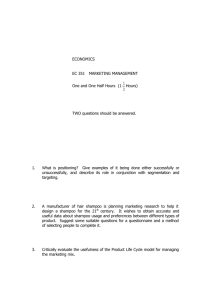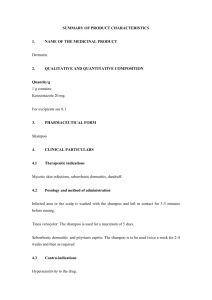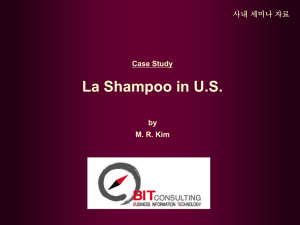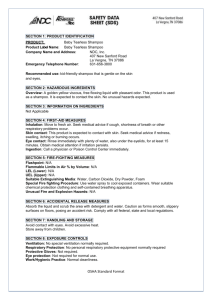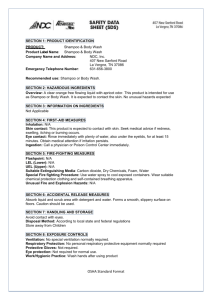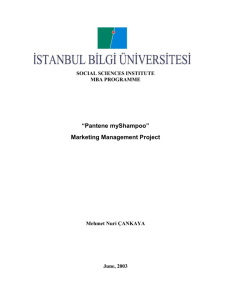indian shampoo brand positioning: multi dimensional scaling
advertisement
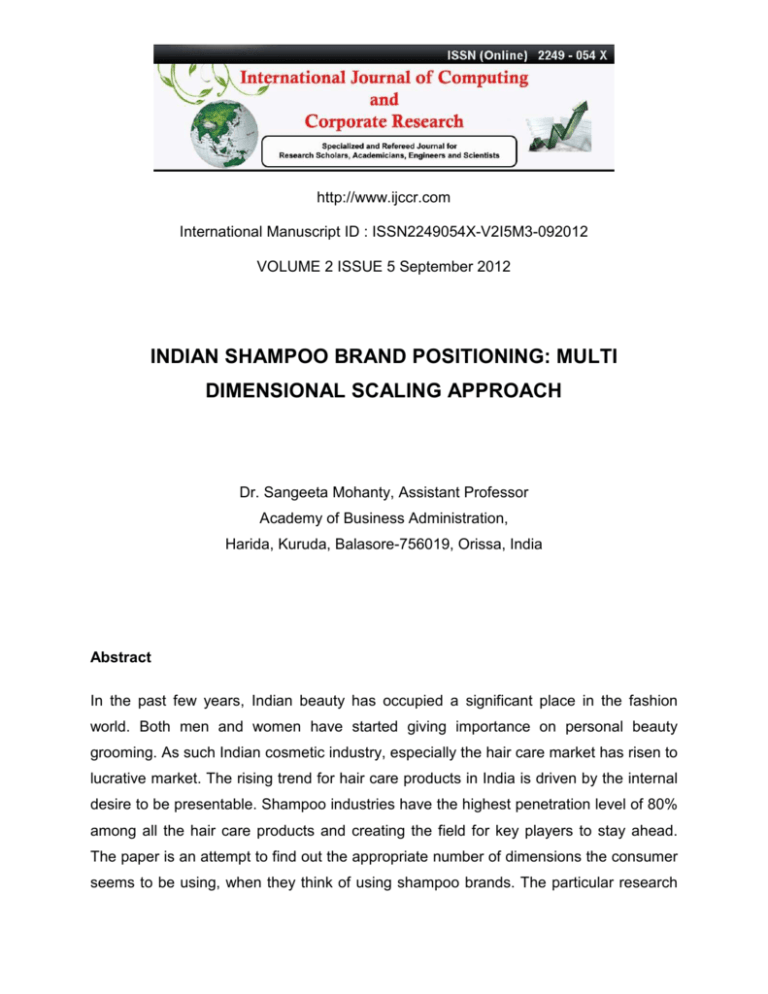
http://www.ijccr.com International Manuscript ID : ISSN2249054X-V2I5M3-092012 VOLUME 2 ISSUE 5 September 2012 INDIAN SHAMPOO BRAND POSITIONING: MULTI DIMENSIONAL SCALING APPROACH Dr. Sangeeta Mohanty, Assistant Professor Academy of Business Administration, Harida, Kuruda, Balasore-756019, Orissa, India Abstract In the past few years, Indian beauty has occupied a significant place in the fashion world. Both men and women have started giving importance on personal beauty grooming. As such Indian cosmetic industry, especially the hair care market has risen to lucrative market. The rising trend for hair care products in India is driven by the internal desire to be presentable. Shampoo industries have the highest penetration level of 80% among all the hair care products and creating the field for key players to stay ahead. The paper is an attempt to find out the appropriate number of dimensions the consumer seems to be using, when they think of using shampoo brands. The particular research http://www.ijccr.com International Manuscript ID : ISSN2249054X-V2I5M3-092012 VOLUME 2 ISSUE 5 September 2012 on prevalence has been conducted to position the different shampoo brand in the way perceived by the Indian consumer. Multi Dimensional scaling technique along with spatial map has been used to elicit the dimensions more clearly. Key Words: Shampoo, Brand, Position, MDS, Dimension, Spatial Map. Introduction Days are gone, when the people were using the home made products for hair care. With the advent of new thoughts, there is an increasing awareness amongst Indian about hair care. The Indians have long been obsessed with the long hair. Particularly south Indians are recognized by their thick, black and long hair. Shampoo industries have identified this aspiration quite well. The shampoo market has acquired significance in urban Indian homes since the 1960s. The market is conquered by dominant players such as Hindustan Unilever Ltd. and Procter & Gamble Company. It is expected that the market will continue to grow with more market players. The changing dynamics of rural people has resulted into substantial increase in the penetration level of the market for both existing and new players. Still the penetration level of shampoo market is low (14%) in Indian market (Indian Cosmetic Sector Analysis (2009-2012)). Urban markets account for 80% of the total shampoo market. The shampoo usage rate is increasing gradually due to decline in excise duty and the use sachet packaging. Sachet packet substantially increased the sales of shampoo http://www.ijccr.com International Manuscript ID : ISSN2249054X-V2I5M3-092012 VOLUME 2 ISSUE 5 September 2012 and the sachet packet sale is more than 70% in south India (www.Livemint.com). The biggest barrier of shampoo usage is the belief that the shampoo contaminated with chemicals will damage the hair as Indians are keen to the usage of herbal cosmetic products. The shampoo industry is characterized by three benefit platforms: cosmetic, anti dandruff and herbal. Anti dandruff shampoo alone accounts for 20% of the total shampoo market and it is growing at 10% to 12% every year (www.researchandmarkets.com). The leading shampoo industries thus came out to solve the specific problem like, hair fall, dandruff, dullness, dryness, damaged hair, and shampoo with herbal intact etc. Different brands claim their characteristics and benefits with a variety of products (table-1). Table-1 Sunsilk (HUL) Dove (HUL) Clinic plus (HUL) Silky, shiny, voluminous strong and black coloured hairs Damage control, daily hair care Strong and long hair, Anti-dandruff shampoo Head and shoulder (Procter Gamble) Pantene (Procter Gamble) Anti-dandruff shampoo Smooth, silky, voluminous, full, lively, long, black hair Chik (Cavin kare) Nyle (Cavin kare) Vatika (Dabur) Fragrance, strength, cool and black hair Herbal shampoo, strength, softness in hair Herbal shampoo, naturalness in hair http://www.ijccr.com International Manuscript ID : ISSN2249054X-V2I5M3-092012 VOLUME 2 ISSUE 5 September 2012 Source: compiled from magazines and television Advertisements The consumers get attracted by the brands possessing special characteristics in product categories. They use the brands of their choices and refer to others for use (Aaker, David A., Rajeev Batra, and John G. Myers (1992). In general consumers perceive the different brand in the way they have become benefitted by the products and accordingly position them on perceptual map. The term Positioning refers to the place occupied by the product in the market (Ramanuj Majumdar, 2008). The concept of positioning evolved first in the field of marketing (Ries & Trout, 1986). Ries and Trout (1986) termed positioning as the act occupying a distinctive image in the target market’s mind.” Brand positioning is a relative concept; it is conceptualized with comparative assessment of a brand with others. The key idea in positioning the brand categories lies in identifying the uniqueness in the product. The association of the consumers with the brand is in general refereed as brand positioning (Aaker, David A., Rajeev Batra, and John G. Myers (1992). The positioning of the brands is made by placing the competitive brands of the product category on comparative rating scale. Multi dimensional scaling is a powerful statistical tool used to condense the data by map by market researchers to depict consumer’s reactions to product features for brand positioning. It is successfully used in positioning a product brand against its competitive brand (Marcus J. Schmidt, Seven Hollensen, 2006). The paper undertakes the use of multi dimensional scaling technique in positioning the shampoo brand in Indian scenario. Successful positioning of brands requires the knowledge of attributes important to users (Kotler’s 2007). The combination of such attributes forms the dimensions in multi dimensional solution. MDS is used for http://www.ijccr.com International Manuscript ID : ISSN2249054X-V2I5M3-092012 VOLUME 2 ISSUE 5 September 2012 measuring the similarities of a set of data on certain identified attributes. It attempts to plot these data in a map; indicating the similarities and dissimilarities as the distances between points (Inger Borg, Patrick J.F Groenen, 2005). The important aspect of MDS is the identification of the dimensions of positioning a brand in perceptual map (Naresh K. Malhotra and Satyabhushan Das, 2011). Indian Shampoo market India’s cosmetic market has undergone its biggest ever evolution in the past decade, giving the people a greater choice of branded shampoo. On an average 20% of all cosmetic products are for hair care. The Indian shampoo market is estimated to be around Rs. 2,700 Cr (Business standard, Friday, July 13, 2012). It has the penetration level of only 14% in India. The shampoo market has captured the rural market to a sizable amount. The market is expected to rise due to increased number of market players and the extensive use of mass media. Currently, the biggest players in this category are HUL and Procter & Gamble. The market shares of leading players are tabulated below. Table-2: Market shares of different brands of Shampoo Brand Company Market share Sun silk, Dove and Clinic plus HUL 47% Head & Shoulder, Pantene Procter Gamble 23 % Chick, Nyle Cavin kare 11% http://www.ijccr.com International Manuscript ID : ISSN2249054X-V2I5M3-092012 VOLUME 2 ISSUE 5 September 2012 Vatika Dabur 5% Source: Compiled from magazines and news papers HUL launched Sunsilk in 1964 as ‘normal cleaning shampoo’, Clinic plus in 1971 as ‘family shampoo’ and Clinic all clear as ‘anti-dandruff shampoo. Dove came into existence by HUL in 2006 as ‘mild soap contents for daily hair care’ with substantially high price targeting the higher income group. HUL continued to lead the market with its highest selling brand Clinic Plus with 32% market share. Procter and Gamble contributed to an average of 40% rise in shampoo market with its ‘anti-dandruff product’ Head and shoulder in 1997. Pantene was launched by Procter and Gamble in 1995 to cater the market with the claim for ‘black, smooth and long hair”. Cavin Care launched Chik in 1983 as popular brand of shampoo among rural Indians and it is remembered for the first innovations of sachet packaging. Later on Nyle was launched by Cavin Care in 1993 to offer benefits through herbal contents. Vatika shampoo was launched by Dabur in 1999 as the shampoo with herbal intact and claimed for ‘naturalness in hair’. Purpose of the study Consumers’ ways of judging the product under normal conditions varies widely, since consumer themselves differ on the basis of age, income, educational level, mobility pattern and taste. The purpose of the study is to transform consumer judgments of shampoo usage similarity into distances in multidimensional space. For that purpose eight different product categories of shampoos such as Sun silk, Dove, Clinic plus, Head & Shoulder, Pantene, Chick, Nyle, Vatika have been included in the survey. http://www.ijccr.com International Manuscript ID : ISSN2249054X-V2I5M3-092012 VOLUME 2 ISSUE 5 September 2012 The basic objective is to place the brands of selected shampoos on the ground of consumers’ perception using Multi dimensional scaling approach. Frame work of Analysis Using Multidimensional Scaling (MDS) Multi dimensional scaling is one of the wide arrays of statistical techniques available for obtaining the perceptual object map for brand positioning. It is functional in finding distinctive brand images. Eight different product categories of shampoos available in the Indian market have been chosen and MDS is used to determine how they are perceived by Indian consumers. Sample The study has been conducted at Balasore, Odisha, located on the east coast of India. A total of 234 people participated in this study, 174 participants are female and 60 are male. The participants were chosen randomly from the city Balasore, belonging to the age group 15 to 45 of different income and educational level. The data collection is age specific as the people of this age group are more beauty conscious and very particular about the usage of shampoo for hair care. Method of Data Collection Each of sample respondents was asked to judge how similar or dissimilar the product categories are, using 1-7 point likert scale, 1-denoting very dissimilar and 7- denoting very dissimilar. Thus for 8 product categories of shampoo, pairs of shampoo products were to be judged These similarity judgments were then presented in a matrix form. A single distance matrix was constructed with integral values by averaging consumers’ judgment matrix to an approximated figure. The particular distance matrix has been treated as input data to be analyzed by SPSS. http://www.ijccr.com International Manuscript ID : ISSN2249054X-V2I5M3-092012 VOLUME 2 ISSUE 5 September 2012 Interpretation of MDS output Tables 2 and 3 are 3-dimensional solution and table 4 and 5 depict 2-dimensional solution. The choice of number of dimensions fitting the data is based on the stress value of 2 and 3 dimensional solutions. Stress value for 3-dimensioanl solution = 0.00369 Stress value for 2-dimensioanl solution = 0.03846 Both the stress values are closer to zero, so both are better. But, 3-dimensioanl solution is the best as its stress value is closer to zero. R-square values (RSQ) in both the dimensions are more than 0.5, the solutions are acceptable. Table-3: Iteration history for the 3 dimensional solutions (in squared distances) Young’s S-stress formula 1 is used. Iteration S-stress Improvement 1 0.01990 2 0.01147 0.00842 3 0.00865 0.00282 4 0.00722 0.00143 5 0.00609 0.00113 6 0.00516 0.00094 Iterations stopped because S-stress improvement is less than 0.001000 Stress and squared correlation (RSQ) in distances http://www.ijccr.com International Manuscript ID : ISSN2249054X-V2I5M3-092012 VOLUME 2 ISSUE 5 September 2012 RSQ values are the proportion of variance of the scaled data (disparities) in the partition (row, matrix, or entire data) which is accounted for by their corresponding distances. Stress values are Kruskal's stress formula 1. For matrix Stress = 0.00369 RSQ = 0.99986 Configuration derived in 3 dimensions Table-4: Stimulus Coordinates Dimension Stimulus Number 1 2 3 4 5 6 7 8 Stimulus Name CLINIC PLUS SUNSILK DOVE CHICK VATIKA HEAD AND SHOULDER PANTENE NYLE 1 -0.8794 1.1447 0.6942 -0.5883 0.1932 0.0096 1.9224 -2.4966 2 -1.0560 -1.6905 -0.6675 -0.2023 1.1672 1.2856 0.9344 0.2291 3 1.2045 -0.3238 -0.2853 -0.5188 -0.5329 0.5483 0.2908 -0.3828 3-Dimensional Solution On dimension-1, Pantene and Sunsilk have the maximum weightage of 1.9224 and 1.1447, Dove has the next highest weightage of 0.6942 and Nyle has the least weightage of (-2.4966). Sunsilk and Dove are HUL product, Pantene is P&G product and Nyle is the product of Cavin kare . Both HUL and P&G are leading the market and http://www.ijccr.com International Manuscript ID : ISSN2249054X-V2I5M3-092012 VOLUME 2 ISSUE 5 September 2012 enjoying their brand image. Looking at their positions, the dimension is named as “Brand Image”. Head and shoulder (1.1672) and Vatika (1.2856) shampoo are leading in dimension-2 at one end, Clinic plus (-1.0560) and Sunsilk (-1.6905) are leading in the second dimension at another end. Thus dimension-2 is named as “Hair care”. Clinic plus shampoo (1.2045) may be perceived as standalone product in dimension-3. It is referred as common men’s product caring value for money. Thus dimension-3 is named as “Value for money”. Table-5: Iteration history for the 2 dimensional solutions (in squared distances) Young's S-stress formula 1 is used. Iteration S-stress Improvement 1 0.09586 2 0.07583 0.02004 3 0.06710 0.00873 4 0.06094 0.00616 5 0.05647 0.00447 6 0.05319 0.00328 8 0.05175 0.00144 9 0.05122 0.00054 Iterations stopped because S-stress improvement is less than .001000 Stress and squared correlation (RSQ) in distances http://www.ijccr.com International Manuscript ID : ISSN2249054X-V2I5M3-092012 VOLUME 2 ISSUE 5 September 2012 RSQ values are the proportion of variance of the scaled data (disparities) in the partition (row, matrix, or entire data) which is accounted for by their corresponding distances. Stress values are Kruskal's stress formula 1. For matrix Stress = 0.03846 RSQ = 0.98906 Configuration derived in 2 dimensions Table-6: Stimulus Coordinates Dimension Stimulus Number 1 2 3 4 5 6 7 8 2-Dimensional Solution Stimulus Name CLINIC PLUS SUNSILK DOVE CHICK VATIKA HEAD AND SHOULDER PANTENE NYLE 1 -0.8267 1.2211 0.5006 -0.5405 0.2807 -0.0020 1.5098 -2.1430 2 -1.2126 -1.3692 -0.4663 -0.0750 1.0250 0.9457 0.8548 0.2976 http://www.ijccr.com International Manuscript ID : ISSN2249054X-V2I5M3-092012 VOLUME 2 ISSUE 5 September 2012 The interpretation of 2-dimensional solution is same as that of 3-dimensional solution. Pantene, Sunsilk, Dove and Nyle ocuupy two extreme ends; the dimension is named as “Brand Image”. Looking at the shampoo categories; Head and shoulder, Vatika shampoo, Sunsilk and Clinic Plus getting high score at two extreme points in dimension2 can be named as “Hair care” The spatial map of 2-dimensional solution is given below. The shampoo products closer to each other create the similar image in customers’ mind. The product which stands alone is perceived uniquely by the customer. Spatial Map http://www.ijccr.com International Manuscript ID : ISSN2249054X-V2I5M3-092012 VOLUME 2 ISSUE 5 September 2012 Derived Stimulus Configuration Euclidean distance model 1.5 vatika head 1.0 .5 pantene nyle chik 0.0 Dimension 2 dove -.5 -1.0 clinic sunsilk -1.5 -3 -2 -1 0 1 2 Dimension 1 It is clear from the map that “Clinic Plus” has the unique brand image and has no real competition with others. The same judgment holds for Pantene, Nyle and Chick to some extent. Dove and Sunsilk have the similar image and facing stiff competition among them. Head and shoulder and Vatika are perceived to be similar in product categories. Conclusion http://www.ijccr.com International Manuscript ID : ISSN2249054X-V2I5M3-092012 VOLUME 2 ISSUE 5 September 2012 Achieving competitive advantage has been the key strategic point in the business. Indian shampoo market is not an exception to it, its sustainable competitive advantage demands proper positioning of brand. Once the target market is identified by the shampoo brand, the challenge is to create an image in the minds of their targeted customer segment. Brand positioning is nothing but creating the identity in the market. One way to do this is to use “Multidimensional Scaling Technique”. MDS provides an idea about the consumers’ perception regarding similarities among the product categories. It is used by the marketing managers for strategic changes in brand positioning. MDS identified three important dimensions “Brand Image”, “Hair care” and “Value for money” to be taken care of by the shampoo industries. Three dimensional and two dimensional solutions gave the same output and identified “Brand Image” and “Hair care” as the most important factors for the choice shampoo brand. The study revealed that “Clinic Plus” has the unique brand image. Dove and Sunsilk have the similar market image. Head and shoulder and Vatika are also similar in their features. References 1. Aaker, David A., Rajeev Batra, and John G. Myers (1992). Advertising Management, 4th ed. Englewood Cliffs, NJ: Prentice-Hall, Inc. 2. Business standard, “The Indian shampoo and hair conditioner market” Friday, July 13, 2012 3. C.K. Ranganathan (2007), “How cavinkare competes with other shampoos companies in Indian Market”. http://www.ijccr.com International Manuscript ID : ISSN2249054X-V2I5M3-092012 VOLUME 2 ISSUE 5 September 2012 4. Dr. Himani Sharma, Shallu Mehta, Customer attitude toward the use of shampoo: A case study of Sirsa City, International Journal of Research in Finance & Marketing, Volume 2, Issue 2 (February 2012) 5. Indian Cosmetic Sector Analysis (2009-2012) RNCOS E-Services Private Limited, April 2011. 6. Inger Borg, Patrick J.F groenen, Modern Multi Dimensional Scaling, Second edition, Springer, 2005 7. Marcus J. Schmidt, Seven Hollensen,Marketing Reserch: An International Approach, Perason Education, 2006 8. Naresh K. malhotra, Marketing Research, Prentice Hall, 2007 9. Priyanka Bhattacharya, India’s Cosmetic Market Ready for Big Leap, GCI Magazine, 2008 10. Priyanka Bhattacharya, Paradigm Shift for India’s Hair Care, GCI Magazine, 2008 11. Ramanuj Majumdar, Product management in India, PHI, 3rd edition, 2008 12. Ries, A.,& Trout, J. (1986). Positioning: The Battle for Your Mind. New York, NY: McGraw-Hill. 13. S. Ramesh Kumar, Nitya Guruvayurappan, Super Shampoo Products and the Indian Mass Market, Source: Richard Ivey School of Business Foundation, 2010. 14. www.researchandmarkets.com – Nitya and Guruvayurappan- Reports on– “India Hair Care Market Analysis, 2010-2014”. 15. www.cavinkare.com 16. www.pgIndia.com- ACNielsen (2004), “Hair care practices of India’s most beautiful woman” http://www.ijccr.com International Manuscript ID : ISSN2249054X-V2I5M3-092012 VOLUME 2 ISSUE 5 September 2012 17. www.gcimagazine.com.-Global Report (2006), “Paradigm shift for India’s hair care”. 18. www.trendsmarket.com- Report on “Sachet marketing”. 19. www.equimaster.com- Report on “The evolving Indian hair care industry”. 20. www.Livemint.com- Sagar Malviya, Report on- “Shampoo sector comes clean again, grows 14%” 21. www.managementparadise.com
